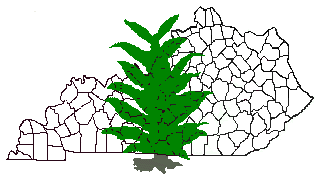

Blue mold has been confirmed so far this season in the counties of Clay, Jackson, Fayette, and Hardin. The Hardin County case consists of a few systemically infected plants without foliar lesions that probably resulted from setting infected transplants. In Jackson County, the activity involved a single, newly developing lesion found by the County Extension Agent while scouting for secondary spread from the Burning Spring outbreak. The other cases have been reviewed in previous status reports. The only additional information about them relates to assay results from the fungicide-sensitivity tests. In Shelby County, laboratory tests confirmed that the population was mixed relative to metalaxyl-sensitivity, in that both highly sensitive and highly resistant fungi were recovered. In Clay County, only the highly resistant strain was detected. All populations tested to date have been very sensitive to dimethomorph.
Blue mold has also been confirmed in burley production of western North Carolina, so remain alert to that situation, because this mountain region is more likely to experience favorable weather during mid summer than is Kentucky.
A little more information about why I am keeping advisories posted for some areas. The overall potential for blue mold outbreaks remains low, because dry weather has persisted in communities with confirmed activity. The most likely places to find new activity are in shady areas of irrigated fields or where shade and fog have combined to make a favorable site near established blue mold. If active blue mold was present last week and infections took place during the moisture events of last week, strong symptoms should develop following the week of cool temperatures the state recently experienced. Abundant sunlight is preventing significant spread of viable spores and lack of moisture has been preventing spore production and the few viable spores present from establishing.
Foliar fungicides are not needed except on farms with active blue mold, or nearby farms under irrigation. However, tobacco growers should keep spray equipment properly maintained and remain alert to the current status of blue mold in the state and community, then adjust rapidly should the needs change. A major effort should be made to destroy ALL transplants not being specifically maintained (with fungicides) for late plantings, lest they become sites to harbor buildup of blue mold.
![]() The Kentucky Blue Mold Warning System's web address is:
The Kentucky Blue Mold Warning System's web address is:
http://
www.uky.edu/Agriculture/kpn/kyblue/kyblue.htm
 Fusarium wilt is common in many burley regions, acting alone or in combination with other diseases. This old enemy, which has been a very minor problem for several decades due to the widespread planting of resistant varieties is increasing in importance now that most varieties planted have little or no resistance. It is most destructive in light soils of creek and river bottom land, but it can also cause serious damage in upland sites, especially when working in conjunction with other diseases. The pathogen is a soil inhabitant (well adapted to persisting by colonizing the soil), thus long survival occurs in soil with little benefit from crop rotation. This disease is best managed with resistant varieties.
Fusarium wilt is common in many burley regions, acting alone or in combination with other diseases. This old enemy, which has been a very minor problem for several decades due to the widespread planting of resistant varieties is increasing in importance now that most varieties planted have little or no resistance. It is most destructive in light soils of creek and river bottom land, but it can also cause serious damage in upland sites, especially when working in conjunction with other diseases. The pathogen is a soil inhabitant (well adapted to persisting by colonizing the soil), thus long survival occurs in soil with little benefit from crop rotation. This disease is best managed with resistant varieties.
Fusarium is also an opportunistic pathogen - taking advantage of a weakened or injured host. It is strongly favored by warm weather, drought stress, and wounding of the host plant. We are detecting it in the float systems once water temperatures are high, but usually it does not seriously weaken or kill plants while they are still in the float system. There is evidence that it is moving into the weaken root system associated with containerized-transplant, giving it a strong "foothold" while the transplant is under stress.
These above factors, plus the widespread planting of susceptible varieties (about 80% of the acreage planted this year is susceptible) are what is driving the marked increase in activity this year. But the trend has been increasing for several years with the shift away from resistant varieties.
Fusarium wilt is best managed through the use of resistant varieties and avoidance of cropping in sandy river bottoms. However, many of the new and more popular varieties have little or no resistance, plus the resistance available is low in most of the other more popular varieties. For example, some of today's most popular varieties are highly susceptible to Fusarium wilt, including: Tennessee 90, Tennessee 86, NCBH 129, NC 2, and NC 3. The resistance levels of many other newer varieties is not well documented or understood. Fusarium wilt resistance is of the horizontal type, and not complete, so it can be overcome with stress.
Fusarium wilt is often found in complexes with other root and stem diseases, and thus its importance can be underestimated. It is especially common to find it associated with black shank, soreshin, or root knot nematodes. There are also several strains of the fungus, and some cause mainly root rots and stunting while others cause extensive wilting (more classic symptoms). Some of these strains can also colonize and build up on the roots of several vegetable crops, such as watermelon, sweet potatoes, white potatoes, and tomatoes. So as cropping patterns change reconsideration of Fusarium wilt's potential is warranted, both for tobacco and the alternative crops.
Be aware that the Fusarium wilt fungus does not respond well to crop rotation, although many of the factors involved in the complex do respond. So crop rotation is recommended to reduced many of the other factors driving Fusarium wilt rather than to reduce the level of Fusarium spores at the site. Therefore, the best control options include crop rotation and the use of Fusarium wilt resistant varieties. If serious Fusarium wilt occurs in resistant varieties, it often indicates the presence of other problems, especially root knot nematodes, because nematodes break resistance to Fusarium wilt. If root knot nematodes are present even at very low levels, they must be controlled also on sites prone to Fusarium wilt, otherwise losses are high even with the Fusarium wilt resistant varieties. In most Kentucky soils, it takes high populations of root knot nematodes to damage burley tobacco if they are the only disease involved. Root knot responds rapidly to crop rotation to grasses in Ky. There are no available burley varieties with resistance to both the nematodes and Fusarium wilt. Soil fumigation is helpful in Fusarium wilt control, mainly because of its impact on other disease organisms involved in predisposing plants to Fusarium wilt.
I urge the burley tobacco industry to seriously reconsider the importance of this disease, especially in its plant breeding programs - return to incorporation of medium to high resistance in cultivars. A decade ago, 80% or more of the crop was set to varieties with medium to high resistance to Fusarium Wilt, while today 80% or more of the crop is set to varieties that are either very susceptible or have low levels of resistance.
Single yellowing tobacco plants or scattered leaves on otherwise healthy plants along field margins or waterways may be the result of tunneling by the common stalk borer. Dry weather can help to force these worms to leave their homes in browning grasses and other plants. The larvae will crawl across the ground and enter the first plant they find that has a stem diameter large enough to accommodate them.
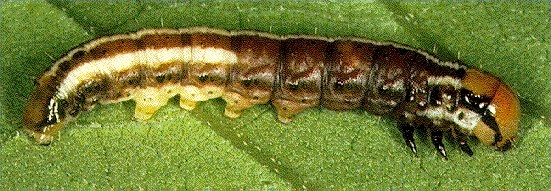 Common stalk borer larvae
Common stalk borer larvae
can be found in tunnels of stalks, leaf stems, or midribs. They are cream colored with a dark
brown or purple band around the body about 1/3 of the way back from the head.. Several dark, lengthwise stripes may
be present. Full grown larvae may lack the dark stripes and band, making them harder to identify.
Budworms
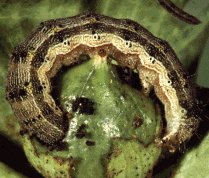 and
yellowstriped armyworms
and
yellowstriped armyworms
 also can enter the plant as they feed. The main message is that there is no effective control measure for insects established within the plant. Fortunately, infestations are very limited and injury is minimal.
also can enter the plant as they feed. The main message is that there is no effective control measure for insects established within the plant. Fortunately, infestations are very limited and injury is minimal.
Stink bugs
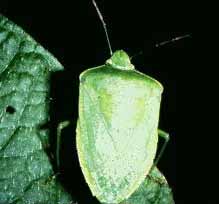 have been plentiful this season, as well (see corn article below). This may lead to higher than normal incidence of damage. Stink bug feeding causes single leaves, or occasionally the bud to wilt in response to the saliva injected and the bug feeds. The wilted leaf will scald while collapsed, especially on hot sunny days. The symptoms develop after the insect has fed and left so treatment rarely pays off.
have been plentiful this season, as well (see corn article below). This may lead to higher than normal incidence of damage. Stink bug feeding causes single leaves, or occasionally the bud to wilt in response to the saliva injected and the bug feeds. The wilted leaf will scald while collapsed, especially on hot sunny days. The symptoms develop after the insect has fed and left so treatment rarely pays off.
 Japanese beetles can be found resting on tobacco plants and occasionally they will do some feeding. They can be a real source of alarm where this is an unusual sight but rarely cause any significant damage. In many cases, it appears that the adults have emerged from the soil in the field and are just sunning on the plants before flying away. Occasionally, a cluster of beetles may feed extensively on a plant or two but wholesale feeding in a field has not been seen and treatment for them is not worthwhile.
Japanese beetles can be found resting on tobacco plants and occasionally they will do some feeding. They can be a real source of alarm where this is an unusual sight but rarely cause any significant damage. In many cases, it appears that the adults have emerged from the soil in the field and are just sunning on the plants before flying away. Occasionally, a cluster of beetles may feed extensively on a plant or two but wholesale feeding in a field has not been seen and treatment for them is not worthwhile.
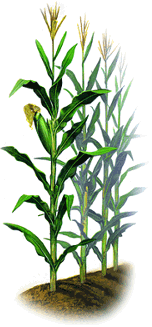
Stink bug damage to corn has been very common this spring across Kentucky. Low numbers of corn plants in many fields
have developed abnormally, with the leaves not emerging from the whorl properly and the plant resembling a bent-over
buggy whip.
 Although there are some herbicides that can cause similar injury to developing corn, these plants were
scattered randomly throughout the field, unlike herbicide injury. This damage was due to stink bug feeding. The
occurrence of this damage may be associated with the mild winter.
Although there are some herbicides that can cause similar injury to developing corn, these plants were
scattered randomly throughout the field, unlike herbicide injury. This damage was due to stink bug feeding. The
occurrence of this damage may be associated with the mild winter.
Stink bugs feed on plant fluids by inserting their needle-like mouthparts into stems, leaves or seed pods. While feeding, they inject materials into the plant to aid in digestion and sap removal. Penetration by the mouthparts can cause physical damage, much like stabbing the plant with a fine needle. A combination of mechanical and chemical damage to the growing point of the plant may be responsible for the injury and symptoms seen in the field.
 Brown and one-spotted stink bugs are the most common stink bugs found attacking corn. These insects are ˝-inch long, shield shaped insects with piercing-sucking mouthparts. The upper side of the body ranges from light to very dark brown. The underside varies from light yellow to green.
Brown and one-spotted stink bugs are the most common stink bugs found attacking corn. These insects are ˝-inch long, shield shaped insects with piercing-sucking mouthparts. The upper side of the body ranges from light to very dark brown. The underside varies from light yellow to green.
Stink bug feeding causes three types of damage. They may kill small seedlings, produce stunted plants, or cause "suckering" (the production of tillers from the base of damaged plants). Frequently a series of plants along a row may exhibit a progression of these symptoms, giving a stair step appearance (dead seedlings, stunted plants, and tillering). Tillered plants may produce little if any grain. Some may produce small ears, with about 1/3 the yield of undamaged plants. Tillered plants may grow to a height of several feet. In effect, they have been converted to weeds, competing for water and nutrients with undamaged plants.
There is usually a row of oval holes with yellow borders across the unwrapped leaves of damaged plants. This row results from the single feeding puncture that penetrates the rolled leaves. A slimy, decaying area may be found in the stalk where the stink bug has fed. The most dramatic symptom is tillering of damaged plants. Tillering usually first appears about 10 days after the damage was caused. Shoots begin to grow from the base and may become as large as the original plant. Damaged plants may develop misshapen ears in place of the tassel.
Stink bug damage is most severe in no-till fields. In no-till, damage can be found throughout the field, often with areas of more intense damage. Frequently these are near wooded areas. Stink bug damage can be found in conventional fields, but the incidence of damaged plants is low and usually frequently limited to the border rows. Early spring weed management may have an influence on stink bug activity. Mowing weeds surrounding fields or other weed management operations during plant emergence may move the insects onto young seedlings.
Surveys in Kentucky and adjacent states have identified a soybean-wheat-corn sequence as favorable for stink bug damage. Stink bugs can build up in soybeans during podfill. Wheat cover crops provide an attractive early spring host for the insects, and subsequently they feed on emerging corn. The stink bugs may overwinter in the wheat stubble, or they may leave the field for over wintering sites and return in the spring.
While it is far too late to do anything about stink bugs this year, if significant damage was noticed this spring, it may pay to scout next year. Preventive programs are not economical or recommended. The two weeks following corn emergence are the critical times to be watching for damage. Scout as you would for cutworms. In addition to looking for cut plants, look for stink bugs and their damage. Stink bugs tend to feed at the base of corn plants, usually an inch above the soil surface. Special attention should be given to fields where stink bug injury has been seen in past years. The insecticides recommended for cutworm "rescue" treatments in ENT-16, Insecticide recommendations for field corn, can be used if a problem is found.
While we really don't need anymore insect pests attacking corn, this week a sporadic one appeared in a late-planted sweet corn test plot on the UK Spindletop Farm. The damage initially appears as a deadheart of the small seedlings that is typical of wireworm injury. The first two leaves of the corn emerged properly, but the 3rd and 4th leaves were wilted. Evidence of tunneling into the crown of the plant was apparent when the soil was removed from around the base of the plant. To that point, it appeared to be caused by wireworms. But near the damage to the crown there was silken webbing forming a small tube. Wireworms don't produce webbing.
Small 3/8 inch long larvae were found tunneling into the stem of the plant. The lesser corn stalk borer is recognized by having alternate bands of purple and green encircling its body. The larvae were either found inside the silken tube or in the ground around the base of the plant. When disturbed, the larva wiggles violently.
The lesser corn stalk borer attacks corn, soybeans, peanuts, other beans and Johnson grass. It attacks the plants from emergence on. Injury is more common under dry conditions and with sandy soils. Rescue treatments are not effective with this insect. How susceptible is Bt corn to this pest? In the field I looked at, there was Bt sweet corn (Attribute, very similar resistance to ECB as with YieldGard field corn) and standard sweet corn. From each Bt corn plot, 100 consecutive plants were examined for lesser cornstalk borer damage and 100 plants from an adjacent non-corn row. The results; Bt-corn 1.67% deadhearts, standard sweet corn 13.67% deadhearts.
This insect occurs throughout the state, feeding primarily on snap beans and lima beans but has attacked soybeans in
counties along the Ohio River in some years.
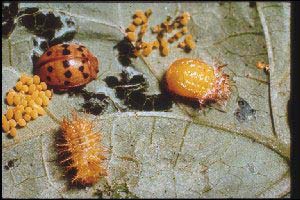 Adult MBB are rounded, copper beetles with 16 black spots on their backs. They are about 5/16" long and 1/5' wide.
Larvae are oval and yellow with branched spines. Full grown larvae are about 1/3" long.
Adult MBB are rounded, copper beetles with 16 black spots on their backs. They are about 5/16" long and 1/5' wide.
Larvae are oval and yellow with branched spines. Full grown larvae are about 1/3" long.
All stages feed on soybeans. Young larvae feed on the underside of the leaf while older larvae eat through the leaf, leaving only the veins. This type of feeding gives the leaves a lacy appearance.
There are usually two generations of this pest each year. The first is usually smaller and often does not require control
measures. It does, however, serve notice that MBB is present. The second generation is usually the most damaging.
Use the shake cloth method of scouting.
(See IPM-3, KY ICM )Scouting Manual for Soybean.
The treatment threshold
varies by plant stage, and can be found in IPM-3 or
ENT-13, Insecticide Recommendations for Soybean.
Control is not
difficult. As usual, the most important decision is whether or not to spray.
 Japanese beetles have spread across Kentucky and are a new pest for many soybean growers. Intense infestations can occur in soybeans with heavy but spotty feeding damage in fields. Usually, the activity begins around smartweed, a particularly favorite food of this insect. Clouds of beetles descend on this common weed and quickly devour it. Since they are already there, the beetles are content to shift over and feed on the beans. The large numbers present can make quick work of surrounding soybean plants, too. Spot treatments can be very effective in dealing with Japanese beetles, especially when they are concentrated on the weeds. Sevin or the pyrethroid insecticides (Ambush/Pounce or Warrior) are quite good against Japanese beetles.
Japanese beetles have spread across Kentucky and are a new pest for many soybean growers. Intense infestations can occur in soybeans with heavy but spotty feeding damage in fields. Usually, the activity begins around smartweed, a particularly favorite food of this insect. Clouds of beetles descend on this common weed and quickly devour it. Since they are already there, the beetles are content to shift over and feed on the beans. The large numbers present can make quick work of surrounding soybean plants, too. Spot treatments can be very effective in dealing with Japanese beetles, especially when they are concentrated on the weeds. Sevin or the pyrethroid insecticides (Ambush/Pounce or Warrior) are quite good against Japanese beetles.
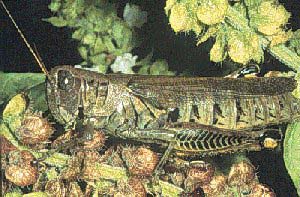 Grasshoppers can be an important foliage feeder on notill beans. Watch for emergence and treat as needed. The materials listed above for Japanese beetle control will work well against grasshoppers.
Grasshoppers can be an important foliage feeder on notill beans. Watch for emergence and treat as needed. The materials listed above for Japanese beetle control will work well against grasshoppers.

A light case of Rhizoctonia stem canker was diagnosed in alfalfa in western Kentucky last week, and other cases may appear throughout the state. Look for scattered plants with individual shoots turning yellow, sometimes with a bit of reddening along major veins. Leaves on these shoots curl from wilting, and the tips of the shoots often droop downward to form a "shepherd's crook". Down at or near the soil line, a lesion (or "canker") is present on the stem, and usually girdles it. The canker may be dark brown or a light brown with a dark brown border. In the field, the disease looks very much like anthracnose, although stem canker generally has been more common in Kentucky during the 1990's.
This alfalfa disease most commonly occurs in new seedings, although it can occur at any time in the life of a stand.
Fields where a sod has been incorporated into the soil often have the highest disease severity. Fresh organic matter
probably serves as a food base for the fungus that causes the stem cankers (Rhizoctonia solani AG-4). Flooding
pre-seeding may favor the disease in some locations. This very same fungus is also active now in causing rotted areas
of roots, which can be seen as black, somewhat superficial lesions on tap roots. R. solani AG-4 is very common in our
soils, and very aggressive under the right conditions. The fungus is unfortunately one of the risk factors that producers
face when growing alfalfa.
Plants showing Rhizoctonia stem canker in a new seeding generally will not recover, although no severe cases have been reported to me this spring. There is no management action that a producer can use as a rescue practice, nor is there really any preplant practice we can recommend to prevent this disease. However, the damage that is visible now is probably all that will occur for the rest of the season. Keep in mind that alfalfa sometimes has a remarkable ability to compensate for missing plants. If the stand is not excessively thin, long-term yields will probably not be affected greatly. Extension Agriculture Agents can provide information on stand densities suitable for hay production and grazing.
Fighting human nature is difficult. When we find a tool that works, we tend to use it until it doesn't work or until a better one is found. When it comes to controlling Colorado potato beetle, this tendency leads quickly to failure. Colorado potato beetle has a tremendous ability to develop resistance to insecticides in a relatively short time. While commercial growers and home gardeners are fortunate to have some new tools to manage this pest, if these new pesticides are exploited and used without regard to resistance management, they will loss their effectiveness quickly.
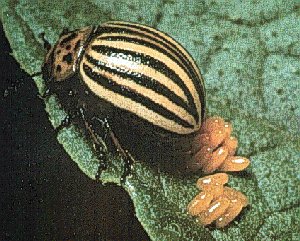 Resistance develops more rapidly when an insecticide is used repeatedly as the only control measure. Also, over- use of one insecticide may favor the development of resistance to others in the same chemical class. Insecticides in the same chemical class usually have the same mode of action, or the same method of killing the insect. Consequently, to delay or prevent resistance it is important to avoid repeated usage of one particular insecticide. Rotate among different classes.
Resistance develops more rapidly when an insecticide is used repeatedly as the only control measure. Also, over- use of one insecticide may favor the development of resistance to others in the same chemical class. Insecticides in the same chemical class usually have the same mode of action, or the same method of killing the insect. Consequently, to delay or prevent resistance it is important to avoid repeated usage of one particular insecticide. Rotate among different classes.
One new product available to commercial growers is spinosad (SpinTor 2SC). This is a new class of chemistry and is used at the rate of 3 to 6 fl oz per application. Home gardeners have some tools that in the past were only available to commercial producers. Home gardeners can now purchase two pyrethroids, permethrin and esfenvalerate, for control of insects on certain vegetables. The real difference between these and those that are used commercially is the reduced concentration formulations for the homeowners.
In order to maintain the effectiveness of these new products, producers should understand and employ some basic principals of insect resistance management. The following are some guidelines to slow the development of resistance:
o Only use insecticides at the labelled rate. When a range is provided, the lower rates are used for lower pest populations and younger stages. Higher rates for high populations and larger larvae.
o Don't use the same insecticide or insecticides from the same class with the same mode of action to control consecutive generations of an insect pest. With Colorado potato beetle, this would mean that producers need to rotate chemical classes each four to six weeks.
o Use economic thresholds to determine the need for action. See ENTFACT-312, Colorado potato beetle management,
We have been receiving inquiries from growers in the drier parts of the state about whether or not there is a need to continue spraying their fruit trees if the residue is still visible on the leaves. The lack of rain for several weeks has limited the washing-off of fungicide residues. Briefly, since fruits are still enlarging and unexpected rains could provide fruit rot infection opportunities, one should probably continue spraying. However, it depends.... It depends on the type of fungicides used. It depends on what kinds of diseases are likely to cause problems in the orchard. It depends on the disease pressure. It depends on how much rain really has fallen.
Fungicides used:
Locally systemic fungicides such as Nova and Rubigan which move inside the leaf, protected from rain, lose their effectiveness after about a week or ten days in any case. The same should be true of Benlate or Topsin-M which are systemic. If they are needed, they might need to be reapplied. Protectant fungicides such as captan or mancozeb are likely still present on the leaves if they are visible. They might not need to be reapplied. There is little information available on how sensitive these protectants are to degradation by sunlight, but most of the concern about loss of effectiveness is related to fungicide removal by rain.
Diseases and disease pressure: Scab - leaf wetness will not likely be prolonged enough to worry about new
infections just now. Should the weather change, the scab fungus, if it is present in the orchard (disease pressure) will
resume activity. Growers can use a fungicide such as Nova to eradicate resulting infections even after the wetting event.
Powdery mildew - this fungus does not need leaf wetness, just high humidity, and we have plenty of that.
If there is a history of powdery mildew in the orchard, then growers should reapply their mildew fungicides because
the captan or mancozeb residues don't control powdery mildew anyway.
Fruit rot diseases - Enlarging
fruits are not well protected because new fruit surfaces appear each day. Relatively short periods of wet weather are
needed for infection, and "pop-up" thundershowers could provide that opportunity. This might be the most compelling
reason to continue with protectant sprays.
Sooty blotch and flyspeck - These diseases are not likely to become active
until much later in the season if dry weather persists.
How much rain? It is said that anywhere from one-half to one inch of rain is needed to deplete half the fungicide residue on the fruit or foliage. It is important for growers to monitor the rainfall in the orchard to at least have an estimate of how much weathering has occurred. If more than half of the fungicide has been lost, it may be time to reapply.

 There is now a new fungicide cleared for use on Grapes and Strawberries, according to recent information provided
by the TomenAgro Company.
The fungicide, called Elevate, is formulated as a 50% water dispersible granule
containing the active ingredient fenhexamid. Elevate is a protectant fungicide used for control of gray mold of
strawberry and bunch rot of grapes, both caused by the fungus Botrytis cinerea. Although this announcement
comes too late for this year's strawberry season, it is possible that growers may want to try this fungicide on
grapes for botrytis bunch rot management. It can be tank-mixed with other protectant fungicides for increased
efficacy and for resistance management. Spray application equipment that provides complete coverage of the foliage
is essential for use of this and other protectant fungicides.
There is now a new fungicide cleared for use on Grapes and Strawberries, according to recent information provided
by the TomenAgro Company.
The fungicide, called Elevate, is formulated as a 50% water dispersible granule
containing the active ingredient fenhexamid. Elevate is a protectant fungicide used for control of gray mold of
strawberry and bunch rot of grapes, both caused by the fungus Botrytis cinerea. Although this announcement
comes too late for this year's strawberry season, it is possible that growers may want to try this fungicide on
grapes for botrytis bunch rot management. It can be tank-mixed with other protectant fungicides for increased
efficacy and for resistance management. Spray application equipment that provides complete coverage of the foliage
is essential for use of this and other protectant fungicides.

Powdery mildew has for several years been the most prevalent disease of flowering dogwoods in Kentucky. It has been frequently observed that there is a pronounced difference in susceptibility between individual dogwood trees. On the most susceptible individuals during the past week, symptoms have progressed rapidly and signs of the fungus (the white powdery growth) have become more visible. A week or two ago, a mottled yellowing of the leaves was the primary symptom, and signs of the fungus were mostly only visible under the microscope. This week, dead patches are appearing on the leaf blades, new growth is showing more distortion, and the fungus is more visible.
Based on our research on landscape dogwoods, a program of four applications of fungicide made at three-week intervals beginning the first of June provides good control of powdery mildew. Thus, if fungicides are being used to manage powdery mildew on susceptible dogwoods, the second application would be made this week. Follow-up sprays made in mid-July and early August would suffice to manage the disease until the end of the season. Fungicides effective for dogwood powdery mildew management include azoxystrobin (Heritage), fenarimol (Rubigan), myclobutanil (Eagle, Immunox), propiconazole (Banner Maxx), thiophanate-methyl (Cleary's 3336), and triadimefon (Bayleton). Individual dogwoods that have been observed in the past to be more tolerant to powdery mildew probably do not need fungicide applications.

Although in most turf swards, Poa annua is considered a weed, there certainly are times on golf courses when so much is present that it is desirable to keep it alive and healthy as a turfgrass. Last week, cases of two diseases of importance on Poa annua were diagnosed on golf courses in the region.
Basal Anthracnose:
This disease appears as patches one to several inches in size of yellowing and dying turf. Aboveground, it is almost
impossible to distinguish this disease from summer patch, which should also be showing up soon. When dissected,
one can find black discoloration in the crown area, from which one can isolate the fungus Colletotrichum graminicola.
Many superintendents are aware that this fungus is known to also cause anthracnose on creeping bentgrass, yet
superintendents note that the creping bent around the dying Poa is usually quite healthy. Recent studies at the
University of Rhode Island have shown that this is what we can expect in most cases, since the researchers found that
almost of the isolates of C. graminicola causing basal anthracnose of Poa were not capable of causing a similar symptom
on creeping bent; different strains were generally responsible for those symptoms on bent.
A variety of practices should be considered for managing this disease. A preventive program of the most effective fungicide treatments can help reduce disease activity. Based on UK research with basal anthracnose on creeping bent, good choices would include: Heritage, tank-mixes of DMI fungicides with chlorothalonil, and possibly tank-mixes of Aliette + iprodione. Cultural practices can also be important. Minimize wounding from practices such as topdressing and aerification when the disease is active, since wounding has been shown to enhance development of basal anthracnose. Maintain a light, steady fertility program through the summer; for example, spoon-feed with 1/8 lb nitrogen/1000 sq ft every 10-14 days. Consider carefully before using Prostar fungicide or Dimension herbicide, which have been shown to enhance anthracnose on colonial bentgrass and creeping bentgrass, respectively. Such cultural practices during hot weather as slightly raising the mowing height, spikeless shoes, fans for air circulation, and the use of smooth rollers may all help to reduce disease pressure.
Southern Blight:
This appears as generally circular patches of blighted grass 1-3 feet in size. Sometimes the center of the patch contains green grass, creating a "frog-eye" appearance. During humid weather, white fungal mycelium will appear at the margin of the affected grass; eventually this mycelium will produce tiny (1 mm), light brown spheres called "sclerotia", the survival bodies of the fungus.
The sustained period of hot weather that ended last week was very conducive for disease development, although disease development was arrested with the advent of cool weather. Among the cool-season grasses grown in Kentucky, Poa annua appears to be the most susceptible. Although I have seen the disease on creeping bent and perennial rye, I have not seen it causing outbreaks that justified treatments. In fact, when we did inoculations with this fungus, Sclerotium rolfsii, in the lab, it was quite difficult to cause disease on perennial rye.
This is a disease that I would scout and treat strictly on a curative basis, in order to minimize unneeded sprays. The disease might help take out Poa in undesirable areas, but that is a day-to-day judgement call that the superintendent must make. Where the combination of initial disease activity and a forecast of continued hot weather justify a curative spray, Prostar fungicide would be my choice. It is labeled and should be quite effective.
Summer Patch:
Although summer patch has not yet been diagnosed, temperatures in the root zone of putting greens in the region have been favorable for over six weeks now, so I expect to begin seeing the disease soon. Any green with a history of the disease should be on a preventive program with Heritage, Banner, or Bayleton. High rates of DMI fungicides (Banner, Bayleton) create concerns among superintendents because of the potential growth regulator effects of these products, especially in hot weather. Injury can occur when high rates of these products are used in conjunction with a turf growth regulator with a similar biochemical mode of action, such as paclobutrazole (Scott's TGR) or triexapac-ethyl (Cutless). Thus, my approach has been to encourage the use of DMI's at summer patch rates until mid- to late-May, and then switch to Heritage during the hot months.
A cultural practice which may reduce summer patch activity is to use acidifying fertilizers whenever possible, such as ammonium sulfate. Recognize, however, that ammonium sulfate can burn leaves when temperatures will exceed 80°F, so wash the fertilizer off leaves or avoid using it under summer conditions. Also, avoid using top dressings above pH 6.0, especially during late spring and summer.
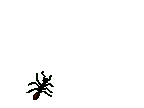
Ant control can be very frustrating-. Repeated attempts often are made to maintain ants at tolerable levels. Recommendations pertain to all of the common ant species found in Kentucky except carpenter ants, which were discussed in an earlier (5/17/99) newsletter.
The mistake most people make when attempting to control ants is only spraying the ones they see. This approach usually fails because the ants seen foraging over exposed surfaces are only a small portion of the colony. Typically, there will be thousands of additional ants, including one or more egg-laying queens hidden somewhere in a nest. The importance of eliminating queens and other colony members within nests cannot be overstated and is the key to effective ant control.
Ants Nesting Indoors- Buildings contain many favorable nesting sites for ants. Preferred sites include spaces behind walls, cabinets, light switches and receptacles, behind window and door frames, and beneath floors. Most of these areas are hidden, making it extremely difficult to determine the precise location of the ant colony. -When the location of the nest cannot be determined, or the nest is inaccessible, insecticide baits are the preferred solution for homeowners. The advantage in using baits is that foraging ants take the insecticide back to the nest and feed it to the queen(s) and other members of the colony. In a relatively short period of time (often within a week), the colony is destroyed.
Ant baits are easy to use. Most homeowner formulations come pre-packaged with the insecticide and food attractant confined within a plastic, child-resistant station. Three of the more effective containerized bait products which can be purchased in most grocery, hardware and discount stores are Combat Quick Kill® and Combat SuperBait® for ants, and Raid Ant Bait Plus with Mettastop®. Place the baits next to wherever ants are seen, preferably beside ant "trails" - invisible odor trails that worker ants follow between food and the nest. Do not spray other insecticides or cleaning agents around the bait stations as this will keep ants from feeding on the bait. Ini-tially, you should see an increase in the number of ants around the bait station. Do not spray them. This indicates that the ants are feeding on the bait and transporting the insecticide back to the nest. Ant activity around the bait station should subside in a few days as the number of ants in the colony declines. Contin-ue to place other baits wherever ants are seen.
Another bait that often works is Terro® Ant Killer II. Terro is formulated as a sweet, liquid bait which certain kinds of ants often prefer. Ants are rather "finicky" in their food preferences and may alter them throughout the year; if one bait product isn't attractive, try another. When using Terro indoors, place dabs of the bait on small squares of waxed paper, or on the back (nonsticky side) of masking tape along ant trails, but away from children and pets. Replace with fresh dabs of bait daily until ant activity ceases.
Ants Nesting Outdoors- Ants noticed inside the home may actually be nesting outdoors in the yard. Trace the ants back to the point where they are entering from outside, such as over a window sill or beneath an exterior door. Nests often will be located in the ground, where they may be marked by a mound or anthill. Other times, the nest will be concealed under stones, mulch, landscap-ing timbers, pavement, or beneath the grass adjacent to the foundation wall. Some kinds of ants prefer to nest underneath siding or behind wood trim that has been moisture damaged. While it takes patience to locate a nest out-doors, results will be more rapid and permanent than if you spray only where ants are seen. One way to entice ants to reveal the location of their outdoor or indoor nest(s) is to place small dabs of honey or maple syrup next to where ants are observed. After the ants have fed, they soon will head back to the nest.
When a below-ground nest is discovered, the colony can be eliminated by thoroughly spraying or drenching the nest location with Sevin, Dursban, or a synthetic pyrethroid such as contained in Spectracide Bug Stop® or Ortho Home Defense System®. Large colonies will require greater amounts of liquid to move the insecticide throughout the network of underground galleries within the nest. Using a bucket to apply the diluted insecticide is an effective method. Follow label directions for treating ant mounds, paying attention to precautions for mixing and application.
Another effective and convenient way to control outdoor and indoor-nesting ants is the granular bait product, Combat® Ant Killing Granules. Sprinkle the bait in small quantities beside outdoor ant mounds, along pavement cracks, and other areas where ants are nesting or foraging.
Ant entry into homes can be reduced by caulking around doors (especially along bottom outside edge of thresholds), windows, and openings where pipes and wires enter the building. Chronic ant problems can further be reduced by spraying one of the above-mentioned liquid insecticide formulations around the outside perimeter of the building. Pay particular attention to likely points of entry, such as around doors and where utility pipes and wires enter from the outside. Also consider applying a 3-to 6-foot swath along the ground adja-cent to the foundation, and a 2-to 3-foot band up the foundation wall.
Broad-cast spraying or applying conventional insecticide granules (e.g., diazinon or Dursban) to the yard seldom, if ever, solves an indoor ant problem. In Kentucky, such applications are a waste of money, effort, and a potential polluter of streams, lakes, and municipal water systems. They also eliminate beneficial ants which may be important allies in suppressing other pests on your property.
Field crop diagnoses this week have included zinc deficiency and acid soil problems on corn; stem canker (Rhizoctonia) on alfalfa; Rhizoctonia root/stem rot and southern blight on soybean.
On tobacco we have seen high numbers of samples with black shank, often in complex with soreshin (Rhizoctonia) and Fusarium stem rot and/or wilt. We have also seen acid soil problems, tomato spotted wilt, tobacco streak, and alfalfa mosaic viruses.
On fruits we have seen Phytophthora root rot on raspberry and black rot on grape. On vegetables we have diagnosed bacterial leaf spot, Rhizoctonia stem rot, southern stem blight on bean; bacterial stalk rot on sweet corn; bacterial wilt on canteloupe, cucumber and squash; early blight, tomato spotted wilt and tomato mosaic viruses, southern blight and Septoria leaf spot on tomato.
On ornamentals we have seen Phythophthora root rot on rhododendron; Rhizoctonia crown rot on impatiens; powdery mildew of dogwood; dollar spot on bentgrass; brown patch on fescue; and slime molds growing on mulch and turfgrass.

| UKREC-Princeton, KY, June 11 - 18 | |
| European Corn Borer | 0 |
| Black Cutworm | 4 |
| True Armyworm | 12 |
| Southwestern Corn Borer | 234 |
| Fall Armyworm | 1 |
| Lexington, KY, June 14 - 20 | |
| Black Cutworm | 0 |
| European Corn Borer | 0 |
| Corn Earworm | 3 |
| Diamondback Moth | 53 |
| Cabbage Looper | 2 |
| Beet Armyworm | 19 |
| Squash Vine Borer | 0 |
Lee Townsend
Extension Entomologist